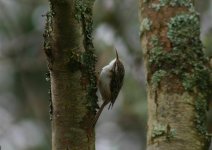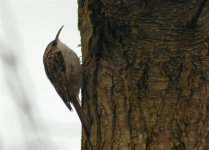-
Welcome to BirdForum, the internet's largest birding community with thousands of members from all over the world. The forums are dedicated to wild birds, birding, binoculars and equipment and all that goes with it.
Please register for an account to take part in the discussions in the forum, post your pictures in the gallery and more.
You are using an out of date browser. It may not display this or other websites correctly.
You should upgrade or use an alternative browser.
You should upgrade or use an alternative browser.
Eurasian Treecreeper or Short-toed Treecreeper (1 Viewer)
- Thread starter Carpie
- Start date
More options
Who Replied?StuartReeves
Local rarity
I'm not sure there is enough detail visible in this photograph to tell, but based on what I can see of the markings on the wing, I would tend to favour Short-toed treecreeper, Certhia brachydactyla.
Stuart
Stuart
Nutcracker
Stop Brexit!
Same here - I'd favour Certhia brachydactyla, but not 100% certain
Edward woodwood
Member
better off trying to hear the difference Carpie!
Tim
Tim
Edward woodwood
Member
longish bill and flank tone point rather towards Short-toed
StuartReeves
Local rarity
The second photo is a bit more helpful and still tends to support C. brachydactyla. The best features for this are the pale spots on the primary tips and the rusty colouration on the flanks and vent. However, these things are not easy and as Tim says, the best way to tell them apart is to hear them sing !
Stuart
Stuart
Edward woodwood
Member
the step in the wing supports Common though
and the hind claw is rather long too.....
and the hind claw is rather long too.....
Touty
Well-known member
Where was it helps most! Cool (mostly evergreen and beech) forests would suggest Common whereas your bird is on deciduous trees... one looks to be a Prunus sp. - this suggests low altitude and Short-toed treecreeper. Here (NE Italy) anything below 1000m on a south facing slope in the Alps is a S-T T.
Nutcracker
Stop Brexit!
Touty said:Where was it helps most! Cool (mostly evergreen and beech) forests would suggest Common whereas your bird is on deciduous trees... one looks to be a Prunus sp
Betula pubescens on the first pic, possibly Ulmus carpinifolia (not definite) on the second pic
hannu
Well-known member
I would say that bird is Short-toed treecreeper, based on the edge of alula and steps
in the primaries (especially photo 1). Also bill seems so longish as Tim says.
I compared between illustrations of bird guides and pictures of Common Treecreeper and I noticed some small differences between them, especially in steps on the primaries !
So illustrations are not always so accurate ...
Hannu
in the primaries (especially photo 1). Also bill seems so longish as Tim says.
I compared between illustrations of bird guides and pictures of Common Treecreeper and I noticed some small differences between them, especially in steps on the primaries !
So illustrations are not always so accurate ...
Hannu
Jane Turner
Well-known member
Hmm.. I need to look harder, but the plumage feature I tend to rely on, (I prefer to hear them) the break in the pale band in the primaries, is very much pointing to Common on this bird. To make it worse, as far as I can see the alula pattern looks better for Short-toed, the bill is certainly more Short-toed like but the other feature I tend to use - the primary spacing (in pic 2), looks more like Common again. I'd not attempt to ID this bird!
Nutcracker
Stop Brexit!
While a UK race Certhia familiaris britannica might, I can't believe a C. f. macrodactyla (the race found in the Netherlands) would ever show flanks this dusky. So pretty good for C. brachydactyla for me.
Gill Osborne
Well-known member
Well I haven't got a clue LOL But lovely photos anyway...Treecreepers are one of my favourite birds.
GILL
GILL
Edward woodwood
Member
what about the 'diagnostic' step wing markings though?
and the hind claw?
this is a photo of contradictions...
I too would leave it
and the hind claw?
this is a photo of contradictions...
I too would leave it
hannu
Well-known member
Compare with these two Finnish Commons;
http://www.tarsiger.com/images/komi/cer_fam_001_0719.jpg
http://www.tarsiger.com/images/masa/Cerfam01.jpg
I would say, it's still STT.
Hannu
http://www.tarsiger.com/images/komi/cer_fam_001_0719.jpg
http://www.tarsiger.com/images/masa/Cerfam01.jpg
I would say, it's still STT.
Hannu
Jane Turner
Well-known member
Tim Allwood said:what about the 'diagnostic' step wing markings though?
and the hind claw?
this is a photo of contradictions...
I too would leave it
On the left-hand pic it does look more continuous, on the right broken..
I've blown the primaries right up on the right hand pic and think there must be a primary tip in shadow or something, since I can't see the bunched tips there should be before the gap that you get in Common Treecreeper.
Not engaged brain on the claw yet!
Edward woodwood
Member
best plumage feature is the super and this does show quiet well on pic one
Common's is whiter and shows more prominently in front of eye than ST
this bird's is whiter than i would expect on a STT but is it also more prominent? You can see the super from other side of head in pic one too but they don't appear to join....which would be a diagnostic for Common
standard ref Harrap and Quinn states many are impossible in the field and some even in the hand.... what chance from a pic!
Common's is whiter and shows more prominently in front of eye than ST
this bird's is whiter than i would expect on a STT but is it also more prominent? You can see the super from other side of head in pic one too but they don't appear to join....which would be a diagnostic for Common
standard ref Harrap and Quinn states many are impossible in the field and some even in the hand.... what chance from a pic!
Touty
Well-known member
Nutcracker said:Betula pubescens on the first pic, possibly Ulmus carpinifolia (not definite) on the second pic
<very old but what the hell - belongs in 'Ruffled Feathers - enjoy it while u can>
Two tall trees, a birch and a beech, are growing in a wood. A small tree begins to grow in between them, and the beech says to the birch, "Is that a son of a beech or a son of a birch?"
The birch says 'I dunno!'l. Just then a woodpecker lands on the sapling.
The birch says, "Woodpecker, you're a tree expert. Can you tell if that is a son of a beech or a son of a birch?"
The woodpecker takes a taste of the sap of the small tree and replies, "It is neither a son of a beech nor a son of a birch. It is, however, the best piece of ash I 've ever had."
Wouldn't want to make a definitive id on the basis of just a couple of pictures but the circumstantial evidence does point to Short-toed in my opinion. In fact all these features would indicate ST rather than Eurasian (or, to put it another way, don't suggest Eurasian):
1) Hindclaw quite short and appearing roughly equal in length to fore-claws (hindclaw usu. clearly longer on Eurasian). Hindclaw is also quite sharply curved; ST often shows shallower gradient.
2) Dusky, dirty-looking flanks and underparts and suggestion of contrasting whitish throat patch.
3) Supercilium v poorly marked in front of eye and falls short of bill base.
4) Long, rather decurved bill.
5) Appearance of pale drop-like spots (good for ST), rather than pale fringes (Eurasian) on the primaries.
6) Mantle looks more streaked than pale-spotted. Eurasian generally gives the reverse impression.
7) Alula on right wing looks as if it might well have a complete pale edge, though difficult to be 100% sure from photo.
In my experience, the wingband is an overrated feature since it varies with posture and apparently too at the individual level. I've seen photos of certain STs (in the hand) that appear to show a jump in the wingband. In any case, I think the wingband on this bird looks ok for ST.
As everyone has said, the call would be the clincher.
Best regards
Greg
1) Hindclaw quite short and appearing roughly equal in length to fore-claws (hindclaw usu. clearly longer on Eurasian). Hindclaw is also quite sharply curved; ST often shows shallower gradient.
2) Dusky, dirty-looking flanks and underparts and suggestion of contrasting whitish throat patch.
3) Supercilium v poorly marked in front of eye and falls short of bill base.
4) Long, rather decurved bill.
5) Appearance of pale drop-like spots (good for ST), rather than pale fringes (Eurasian) on the primaries.
6) Mantle looks more streaked than pale-spotted. Eurasian generally gives the reverse impression.
7) Alula on right wing looks as if it might well have a complete pale edge, though difficult to be 100% sure from photo.
In my experience, the wingband is an overrated feature since it varies with posture and apparently too at the individual level. I've seen photos of certain STs (in the hand) that appear to show a jump in the wingband. In any case, I think the wingband on this bird looks ok for ST.
As everyone has said, the call would be the clincher.
Best regards
Greg
Users who are viewing this thread
Total: 2 (members: 0, guests: 2)





